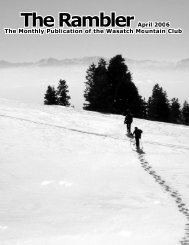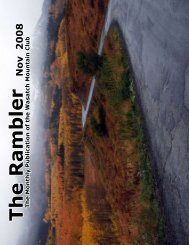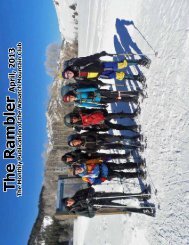Rambler
September 2010 - Wasatch Mountain Club
September 2010 - Wasatch Mountain Club
- No tags were found...
You also want an ePaper? Increase the reach of your titles
YUMPU automatically turns print PDFs into web optimized ePapers that Google loves.
ONE OF THE WORLD'S GREATEST WHITEWATER ADVENTURES!<br />
In the late 1860s Major John Wesley Powell<br />
and his party ran the Green and Colorado<br />
rivers. It was one of world’s greatest<br />
whitewater adventures. Powell and his<br />
men used three, twenty-one-foot-long oak<br />
boats, and one, sixteen-foot pine boat<br />
down--each vessel powered by oars and<br />
turned by a stern sweep.<br />
Powell, a scientific man, collected bits and<br />
pieces of natural information along the<br />
way. At one point on the journey, he and THE START FROM GREEN RIVER STATION<br />
his assistant, named Bradley, scaled the<br />
canyon walls to take a barometer reading to determine altitude. The climbing became difficult for<br />
the one-armed Civil War veteran. He reached up to hold onto a rock above him and suddenly found<br />
himself posed delicately on a precipitous cliff, on the verge of<br />
falling off and tumbling onto the boulders below.<br />
“The moment is critical,” he wrote. “Standing on my toes, my<br />
muscles begin to tremble.” Bradley scrambled above him, but<br />
was not able to obtain a close enough position to reach Powell.<br />
He frantically scanned the rocky cliffs looking for a branch of<br />
a tree to hand to Powell clinging below him, but nothing was<br />
available.<br />
Then Bradley had an idea. Pulling off his trousers, he hung<br />
them down to Powell. Powell grabbed the trousers and was<br />
pulled to safety.<br />
The adage that small events change the course of history was proven true again. Powell might not<br />
have completed running the wild rapids of the Colorado and explored one of the last unmapped,<br />
unknown parts of the United States had it not been for Bradley’s drawers.<br />
Powell went on a second expedition on the Colorado using boats similar to those on the first, but this<br />
time he sat on a chair lashed high on the deck and scouted the coming rapids. These days, Powell<br />
probably would have to pay big money to get people to row his boats. His system wasn’t all that<br />
oarsmen-friendly. Nowadays oar boats are rowed with oarsmen looking downstream. They can see<br />
what’s coming at them. But in Powell’s boats the oarsmen rowed with their backs to the oncoming<br />
rapids and depended blindly on the major shouting out orders to them.<br />
During the years after Powell’s journeys, wooden boats were improved for whitewater use. Metal<br />
and fiberglass dories that now are used on many western rivers are a direct outgrowth of the earlier<br />
models. Rubber rafts, then, began to appear, and especially proliferated when surplus rubber rafts<br />
were available at the end of World War II.<br />
Rafts manufactured today are constructed of various types of synthetic materials. They come in<br />
a variety of sizes and shapes. Their distinguishing characteristic is that they are pliable but tough<br />
enough to absorb the shocks of banging and scraping against rocks without damage--most of the<br />
time, that is. (From The Whitewater River Book by Ron Watters.)<br />
43
















